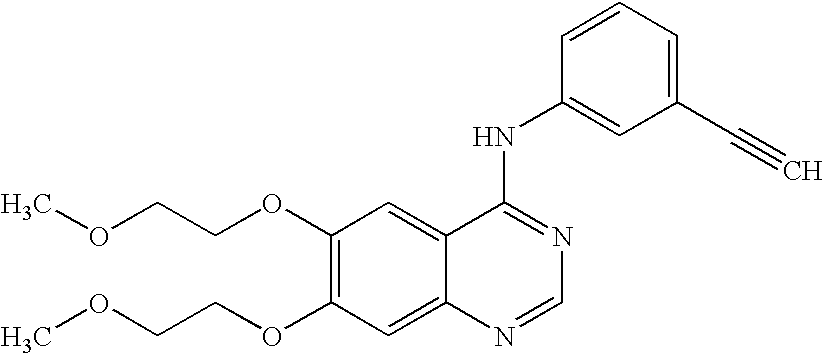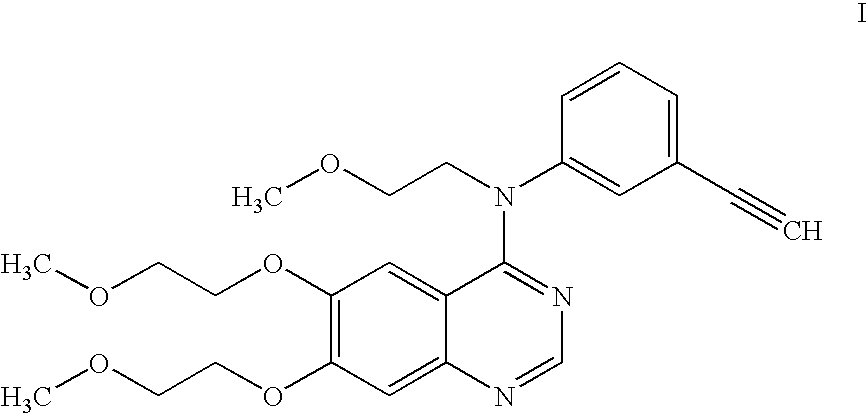Process for erlotinib hydrochloride
a technology of erlotinib and hydrochloride, which is applied in the field of process of erlotinib hydrochloride, can solve the problems of inability to purify, poor yield of erlotinib hydrochloride obtained by the process described in the '498 patent, and inability to meet the purity requirements of the produ
- Summary
- Abstract
- Description
- Claims
- Application Information
AI Technical Summary
Problems solved by technology
Method used
Image
Examples
reference example 1
[0045]6,7-Bis(2-methoxy-ethoxy)-quinazolone (68 gm), chloroform (1360 ml) and dimethylformamide (7.5 ml) are taken in a reaction flask at 25-30° C. and start stirring. To the contents added oxalyl chloride (120 ml) at 25-30° C. slowly for 30 minutes, heated to reflux for 1 hour 30 minutes. Distilled the solvent at 55-60° C. under vacuum, diisopropyl ether (560 ml) is added, cooled to 25-30° C. and then stirred for 30 minutes. Filtered the compound and washed with diisopropyl ether (100 ml). The compound is added to chloroform (1000 ml), washed the chloroform two times with 8% NaHCO3 solution (each time 680 ml) and the resulting organic layer is washed with water (500 ml), dried the organic layer over sodium sulfate and distilled the solvent under vacuum at 55-60° C. To the residue added n-heptane and stirred for 1 hour at 25-30° C. Filtered the material, washed with n-heptane (100 ml) and then dried the material at 50° C. under vacuum to get 65 gm of 4-Chloro-6,7-bis-(2-methoxyethox...
reference example 2
Step-I:
[0046]4-Chloro-6,7-bis-(2-methoxyethoxy)-quinazoline (63 gm) and isopropyl, alcohol (990 ml) are added to 3-ethynylaniline (23.6 gm) at 25-30° C. under stirring, the contents are heated to reflux and then refluxed for 1 hour 30 minutes to 2 hours. The reaction mass is cooled to 25-30° C. and stirred for 30 minutes. Filtered the material, washed with chilled isopropyl alcohol (400 ml) followed by n-hexane (300 ml) and then dried the material at 50-60° C. under vacuum for 6 hours to give 75 gm of crude erlotinib hydrochloride [HPLC purity: 97%; Content of N-methoxyethyl impurity: 0.24% (at 1.14 RRT)].
Step-II:
[0047]Crude erlotinib hydrochloride (37 gm, obtained in step-I), water (370 ml) and chloroform (370 ml) are taken into a reaction flask at 25-=30° C. and start stirring. The contents are heated to 50-55° C., sodium hydroxide solution is added at 50-55° C. and then stirred for 15 minutes at 50° C. (clear solution not observed). To the reaction mass added chloroform (200 ml) ...
example 1
[0049]4-Chloro-6,7-bis-(2-methoxyethoxy)-quinazoline (50 gm) and dimethyl sulfoxide (250 ml) are added to methanol (500 ml) under stirring at 25-30° C., 3-ethynylaniline (20.5 gm) is added to the reaction mixture at 25-30° C. and then the contents are heated to 85° C. The reaction mass is stirred for 2 hours at 80-85° C., cooled the mass to 25-30° C. and then stirred for 1 hour. Filtered the material, washed with a mixture of dimethyl sulfoxide (50 ml) and methanol (100 ml), and then dried at 60° C. under vacuum for 4 hours to give 60 gm of erlotinib hydrochloride [HPLC purity: 99.65%; Content of N-methoxyethyl impurity: 0.09% (at 1.14 RRT)].
PUM
| Property | Measurement | Unit |
|---|---|---|
| Temperature | aaaaa | aaaaa |
| Temperature | aaaaa | aaaaa |
| Temperature | aaaaa | aaaaa |
Abstract
Description
Claims
Application Information
 Login to View More
Login to View More - R&D
- Intellectual Property
- Life Sciences
- Materials
- Tech Scout
- Unparalleled Data Quality
- Higher Quality Content
- 60% Fewer Hallucinations
Browse by: Latest US Patents, China's latest patents, Technical Efficacy Thesaurus, Application Domain, Technology Topic, Popular Technical Reports.
© 2025 PatSnap. All rights reserved.Legal|Privacy policy|Modern Slavery Act Transparency Statement|Sitemap|About US| Contact US: help@patsnap.com


